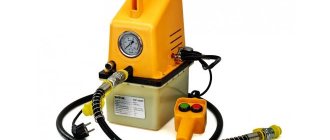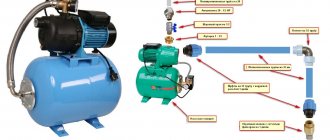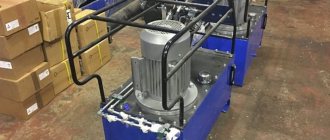Design Features
The main purpose of hydraulic oil stations is to convert various types of energy into mechanical energy of fluid flow. Thus, the result of the operation of this device is the transmission of working fluid under a certain pressure to the executive bodies of the equipment connected to the oil station.
Design of a typical hydraulic oil station
The design of any hydraulic oil station consists of the following elements.
Working fluid tank
The inner walls of such a tank, which can be made of ordinary or stainless steel, are processed using sandblasting technology and coated with a double layer of a special polymer composition. Oil stations that operate intensively are equipped with tanks with additional internal partitions, the purpose of which is to facilitate cooling and mixing of the working fluid. The tanks with which any hydraulic oil station is equipped simultaneously perform several functions, namely:
- serve as a reservoir containing working fluid (oil);
- used to cool the working fluid;
- act as a coarse filter in which contaminants contained in the working fluid are deposited;
- serve to separate water and oxygen contained in it from the working fluid;
- used to supply working fluid to pumping equipment.
Hydraulic tank design
It can differ both in its design and technical characteristics. One of the most important characteristics of a pump is the flow rate of the working fluid that it is able to provide. This parameter, depending on the type and specific model of pumping equipment, can be in the range of 3–300 l/min. The pumps that are equipped with hydraulic oil stations are one of the following types:
- lamellar;
- gear;
- radial plunger;
- axial piston.
Oil station pump Willy Vogel-DM7
The main function of this element is to convert one type of energy (mechanical energy of compressed air or liquid, electrical, chemical energy of consumed fuel) into the energy of movement - rotational or translational. Depending on what energy the prime mover is intended to convert, it can be:
- pneumatic or hydraulic;
- electrical;
- petrol or diesel.
Pipeline This is a system of channels, which may include high-pressure hoses, metal pipes, special plates mounted on a butt or modular principle. The pipeline with which each oil station is equipped simultaneously performs several important functions:
- connects the hydraulic pump to the working parts of the oil station (control, distribution and regulating equipment);
- ensures the process of pumping working fluid to the executive body;
- is responsible for returning the working fluid back to the hydraulic tank.
High-pressure pipelines
Its task is to clear the working fluid returning to the hydraulic tank from foreign impurities.
This element cleans the working fluid coming from the storage tank to the hydraulic pump from foreign impurities. This filter, which is installed directly at the outlet of the storage tank, must prevent solid impurities contained in the working fluid from entering the pump line. Since the suction capabilities of the hydraulic pump are limited, the filters located between it and the storage tank must create minimal resistance. Suction filters, some models of which include a magnetic separator or bypass valve in their design, provide only rough cleaning of the working fluid.
Design of some filters for oil stations
The neck is equipped with an air filter that prevents foreign impurities from entering the working fluid at the moment when the hydraulic tank is opened.
This includes pressure gauges and indicators of the amount of working fluid in the hydraulic tank.
These elements can be one of two types: electro-hydraulic and manually controlled (such devices can consist of one or more sections).
Hydraulic oil station: device, operating principle and features
In the process of mechanized work, a hydraulic oil station has become an indispensable element. And in order to choose the right one for you, you need to know the operating principle and characteristics of oil stations.
The task of a hydraulic oil station is aimed at converting energies into a single mechanical force of a liquid flow. Consequently, the design distills the compressed liquid to the main components of the apparatus connected to the oil station.
The oil station device consists of the following components:
Liquid tank. The inner shell of the tank is made of steel, processed using sandblasting technology and with a two-layer polymer coating. The oil stations that are used the most have special tanks installed. They have several partitions that help reduce the temperature of the working fluid.
The station tanks perform the following functions:
- serve as a tank for the solution;
- lower the station temperature;
- filter liquid contaminants using deep cleaning;
- separating air and liquid from the working fluid;
- supplies oil to the pumps.
Pumping station . All different types, the characteristics of hydraulic oil stations vary. The main one is the flow rate of liquid components. Depending on the type of pump, this value ranges from 3 to 300 meters per 60 seconds.
Hydroelectric pumping stations are classified as follows:
- axial piston;
- radial piston;
- gear;
- lamellar.
Engine. Performs the main function of transforming different energies into a single one - motor. The classification of motors depends on what kind of energy the device converts.
- electric;
- gasoline (diesel);
- pneumatic.
Pipeline. A mechanism that consists of pipes, pressure “sleeves” and butt or modular special plates. In a hydraulic power station, the very principle of operation is important in use for:
- coupling of pumps with other moving elements of the oil station;
- fluid flow to the main organ;
- pumping a liquid element into a hydraulic reservoir.
Drain filter. Cleans the solution on its way back to the hydraulic reservoir.
Suction filter . Cleans the liquid from contaminants on the way from the reservoir to the pumping station. The filter is installed at the outlet of the tank. Its job is to prevent foreign materials from entering the pump.
Fill neck . Prevents excess elements from entering the working fluid when opening the hydraulic tank.
Measuring instruments . Pressure gauges and instruments indicating the volume of liquid in a tank.
Distribution devices . They are classified into manual and electro-hydraulic.
Operating principle of the oil station
The task of the apparatus is to convert energy using compression and liquid flows.
The device functions as follows:
- the engine transfers energy through the rotation of its shaft to the hydraulic one;
- the pump draws the solution from the reservoir using filtration;
- the liquid spreads to the components of the device using pipes, they contribute to its uniform distribution, pressure and supply to the cylinder and motor;
- The working fluid makes a circle in the device and flows into the container using a drain filter.
Advantages of an oil hydraulic station
Instead of an oil system, you can use compressor units, but over them, an oil station has a number of irrefutable advantages.
- Price. The system is compact, which saves money on transportation and installation.
- Cost. The oil system significantly reduces electricity consumption.
- Performance. Hydraulic oil stations are more powerful and efficient.
- Noise. The unit operates much quieter than compressor units.
- Ease of use. Does not require the services of additional specialists.
Hydraulic oil systems are used in various fields due to their versatility and universal design. Thus, they can be used for:
- electrical installation equipment;
- railways and construction sites;
- slurry pumps and pumping stations;
- lifts for large loads.
The principle of operation of a hydraulic station is to pump a substance under compression, so they are used in the case of preliminary tests of pipelines, hydraulic cylinders and various types of equipment. Most often used in the fields of mechanical engineering, metallurgy, agriculture, transport and energy.
Characteristics of the hydraulic oil station
Oil stations and their characteristics are grouped according to special parameters. One of these is mobility; this parameter includes:
- Mobile. Compact installations that can be moved and installed at no extra cost;
- Stationary. Large installations that are capable of creating maximum pressure;
- Self-propelled. Powerful and at the same time easily transportable systems.
Depending on the type of engine, there are:
- diesel or gasoline;
- pneumatic;
- hydraulic.
If the gasoline engine operates on the principle of internal combustion, pneumatic with the help of a powerful compressor. But the most reliable in use is a hydraulic station with a pneumatic drive.
Oil stations are also grouped by device distribution. The systems are distinguished:
- Manual type. The main interaction is reproduced using a hydraulic lever;
- Two-position type. There is enough energy for the circulation of matter in the installation.
- Three position type. They work according to the movement-hold-return type.
The pressure is distinguished:
- weak – 16 MPa;
- average – 42 MPa;
- strong – 155 MPa;
- heavy-duty – more than 155 MPa.
The controls are classified into:
- manual;
- electromagnetic;
- automatic.
Depending on the type of drive, oil stations are distinguished as follows:
- Single stage. They operate using a single-flow pump, which allows you to regulate the operating mode.
- Two-stage. Thanks to a special hydropanel, energy consumption is significantly reduced.
What to look for when choosing an oil station
To use the device to its fullest extent, you should choose it correctly and study the technical characteristics of oil stations. The market offers a lot of options with different price variations, which are formed depending on:
- type of engine;
- degrees of pressure and power;
- distribution systems;
- transportation possibilities;
- manufacturer.
First of all, you should take into account the productivity and power of the installation, as well as the volume of the reservoir and the force of liquid pressure, in other words, the characteristics of the hydraulic station. You should also know about:
- drive compression force;
- piston volume;
- chassis size and speed;
- type of drive and equipment configuration.
When choosing an oil station, the main factor is the volume of the tank, which should be a quarter larger than the other elements of the device. If a station is needed to perform different tasks simultaneously, then it must be equipped with a multiport pump or have a multiport valve.
And also the presentation should not be ignored. This indicator must be consistent with the characteristics of all systems. Otherwise, the hydraulic oil station device will function poorly, or it will break if the supply is excessive.
Why is it worth buying a hydraulic station from the Hydroleader company?
- Our managers are ready to advise you on the selection and technical characteristics of oil stations;
- Our hypermarket has the lowest prices for hydraulic equipment throughout Russia;
- Our company provides a guarantee for the entire range of products;
- The catalog range of items is constantly expanding, and new spare parts for your equipment are appearing.
You can learn about the operating principle of the oil station on our website. You can also make a purchase at any time convenient for you, and our managers will contact you to confirm it. The Hydroleader company will also be happy to advise you on the design of a hydraulic oil station.
Purpose of the oil station
Hydraulic oil station with electric drive type NEE18-3I20T1 is designed to create hydraulic energy and use it in a bench installation to test the functioning of steering racks. The oil station is made in climatic version “U” of placement categories 2, 3 according to GOST 15150-69. Ambient temperature from plus 5°C to plus 40°C. Working fluid: VMGZ TU 38 101479-86, MGE-10A OST 38 01281-82. The cleanliness class of the working fluid must be at least class 10 according to GOST 17216-71. The temperature of the working fluid during operation of the pumping unit should be in the range from plus 5°C to plus 50°C. The operating position of the pumping unit is horizontal. Tilt up to 5° in any direction is allowed.
Hydraulic oil station design
The oil station is used to convert various types of energy into mechanical fluid energy. The hydraulic oil station pumps hydraulic fluid and creates pressure in the working area of the actuators.
The hydraulic oil station is characterized by the presence of:
Principle of operation
Hydraulic oil stations have a number of other names - “hydraulic drives”, “hydraulic stations” or “hydraulic units”. However, no matter what such a device is called, its purpose always remains the same and is to convert energy by controlling the pressure and flow of the working fluid. The type of energy converted, as mentioned above, determines the type of prime mover, which is the main part of any oil station.
Hydraulic diagram of the oil station
If we briefly describe the principle by which the hydraulic station works, it is as follows.
- The prime mover of such a device, consuming a certain energy in accordance with its type, transmits torque from its shaft to the shaft of the hydraulic pump.
- The running hydraulic pump begins to suck the working fluid from the storage tank through the suction filter.
- The working fluid flows through the pipeline system to the corresponding elements of the system. They ensure the distribution of fluid, determine its pressure, and supply it to a hydraulic cylinder or hydraulic motor, which do the main work.
- The working fluid, which has already passed through all the required sections of the system, returns to the storage tank, having previously passed through the drain filter.
Comments
How many kilograms does such a pump produce?
the starter has a maximum of 200 rpm and the pump has 2600 - I wonder HOW it works
Directly, the starter power is not enough, the pump will not produce full power
It is not clear what the alignment of the starter armature can be with a splined connection? if the anchor is on bushings.
You can pump water with this thing
relevant for converting a gazelle into a dump truck
Hello! What is the purpose of this system?
and on the tractor the pump has an adapter plate with bearings, won’t it break the NS?
Great idea ! Let's wait for the continuation!
Areas and advantages of application
An alternative to using oil stations is to use compressor-type units. However, if we compare installations of these types, then hydraulic power stations for hydraulic drives have a number of advantages.
- Due to the more compact size of such equipment, you have to spend significantly less money on its transportation, installation and operation.
- When operating hydraulic oil stations, significantly less energy resources are consumed, which also leads to a reduction in financial costs.
- Oil stations, compared to compressor equipment, have higher productivity and efficiency of use.
- The wide versatility of such equipment allows it to be connected to devices of various types and power.
- Compared to compressor equipment, oil stations produce significantly less noise during operation.
- Due to the ease of use and maintenance, specially trained, highly qualified personnel are not required to work with such equipment.
Pumping station as part of a hydraulic pipe bender
Hydraulic stations, naturally, are used to equip equipment on which a hydraulic drive is installed. In fact, with the help of such devices it is possible to operate a mechanism for almost any purpose. That is why hydraulic oil stations are successfully used in many areas. The technical capabilities and versatility of such devices allow them to be used for:
- static type hydraulic tools;
- electrical installation equipment;
- dynamic type hydraulic tools;
- equipment for railway and construction purposes;
- pumps and slurry pumps;
- equipment for drilling operations;
- injection molding machines;
- press equipment;
- devices used to lift and move large and heavy loads;
- equipping test stands;
- technological equipment for various purposes.
Oil station of a lathe
Using hydraulic oil stations, they pump and purify oil, and also lubricate and cool working elements of equipment for various purposes. Oil stations are used quite actively in cases where it is necessary to test pipeline systems, hydraulic equipment, hydraulic cylinders and various equipment.
If we talk about the areas of activity in which hydraulic oil stations are most actively used, then this should include:
- mechanical engineering;
- metallurgy;
- energy;
- construction;
- Agriculture;
- transport sector.
Oil station equipment
- 1) Tank
- 2) Cover
- 4) Gear pump
- 5) Electric motor
- 6) Coupling with elastic element
- 7) Glass
- Four-line three-position hydraulic valve with electromagnetic control
- 9) Hydroblock
- 11) Safety valve
- 13) Pressure gauge
- 14) Pressure gauge stand
- 15) Filler neck with strainer and breather
- 21) Suction filter
- 22) Drain filter
- 23) Oil level indicator combined with a thermometer
- 24) Cork
Force created by hydraulic cylinders of different diameters and extension time
| Hydraulic cylinder liner diameter (mm) | Extension time per 100 mm (sec) | Force (kg) |
| 30 | 0.2 | 1150 |
| 40 | 0.4 | 2000 |
| 50 | 0.6 | 3200 |
| 60 | 0.85 | 4600 |
| 70 | 1.2 | 6200 |
| 80 | 1.5 | 8200 |
| 90 | 2 | 10370 |
| 100 | 2.4 | 12800 |
Parameters and classification
Hydraulic oil stations are divided into various types according to several parameters. So, according to the degree of mobility, devices are distinguished:
- mobile (they are characterized by the most compact size and light weight, due to which they are easily moved even without the use of additional equipment, have the lowest power among devices of similar purpose and are used mainly in the private sphere);
- stationary (large-sized oil stations, which allow creating high pressure on the executive body, are used to equip production enterprises);
- self-propelled (successfully combine the high power of stationary devices and excellent mobility, which is ensured by the presence of a self-propelled wheelbase in their design).
Stationary diesel oil station for pushing installations
Depending on what type of prime mover is used to equip the oil station, such a device can be:
- electrical;
- hydraulic;
- pneumatic;
- gasoline;
- diesel
Mobile oil station based on a gasoline internal combustion engine with a capacity of 7.5 liters.
With. and a capacity of 20 l/min. Gasoline oil stations, which are driven by an internal combustion engine, are distinguished by the most compact dimensions among units of this type. The main working element of pneumatic oil stations is the compressor, which must develop a compressed air pressure of at least 0.5 MPa. The most reliable devices used in those areas of activity where strict requirements are imposed on their functioning are hydraulic oil stations, the design of which is supplemented with a pneumatic drive. The design of oil stations of this type is also different in that their working elements are lubricated by spraying the working fluid.
Depending on what type of switchgear is used to equip oil stations, the latter are divided into the following types.
- With manual unloading crane. Through the use of such a valve, the pressure of the working fluid is injected and released in the hydraulic cylinder of the system. Oil stations of this type are equipped with equipment with a spring return mechanism. Such equipment, in particular, includes pipe benders and hydraulic nut cutters.
- With switchgears of two-position type. In oil stations equipped with distributors of this type, the working fluid is pumped under such pressure, which is sufficient not only for the operation of the executive body, but also for returning the fluid back to the storage tank.
- With three-position switchgear. Through the use of such distribution devices, oil stations of this type ensure the functioning of the executive body in three positions: working stroke - holding - return. Such hydraulic stations are used to equip pressing equipment and car lifts.
The Feller GS-15-2 double-flow oil station with a manual three-position distributor is used as a drive for double-acting hydraulic equipment.
Oil stations also differ depending on the operating pressure they create. So, according to this parameter, hydraulic stations are distinguished:
- weak pressure, the value of which does not exceed 16 MPa;
- medium pressure devices – up to 45 MPa;
- hydraulic power stations providing high pressure – up to 155 MPa;
- heavy-duty oil stations, the value of which exceeds 155 MPa.
According to the control method, oil stations can be one of the following types:
- manual devices, controlled by a special handle;
- electromagnetic type oil stations, the design of which includes a control element such as a push-button station or remote control;
- devices with automatic control, which have both a handle and a push-button station.
Oil station controls HAG-12-20
Depending on the type of hydraulic drive used, oil stations can be single- or two-stage.
- The operation of single-stage oil stations is ensured by a single-flow hydraulic pump. Due to the design features, hydraulic stations of this type allow adjustment of the operating modes of the hydraulic cylinder. Devices of this type are used in cases where the force applied when compressing the pressed object must be the same. In particular, such a hydraulic station is optimally suited for presses used in waste briquetting, wood gluing, pressing and pressing.
- Two-stage oil stations are equipped with dual pumps and a bulkhead hydraulic panel. Hydraulic stations of this type, due to the features of their design, can significantly save energy.
Main types of hydraulic oil stations
Hydraulic oil stations are divided according to several parameters. Depending on the type of movement, they are:
The first type is characterized by compact dimensions and is easy to transport. Mobile oil stations have low power and are used in the private sector.
Stationary devices are used in industry. Such oil stations have large dimensions and operate at high power.
Self-propelled hydraulic oil stations combine the advantages of the two previous types. They have both high power and means of transportation, and in particular wheels.
Depending on the prime mover, the oil station is:
Oil stations based on a gasoline engine are the most compact. To operate a pneumatic oil station, a compressor is required, the minimum operating pressure of which is 0.5 MPa. Hydraulic oil stations based on a pneumatic drive are used in enterprises that have strict operational requirements, and in particular, in petrochemical or mining plants. Such oil stations have a longer service life and use devices that provide system lubrication by spraying the working fluid.
Depending on the type of distributors, hydraulic oil stations are:
According to pressure, oil stations are:
Hydraulic oil stations differ in the way they are controlled and are:
In the first type of oil stations, the operation is controlled using a handle. The electromagnetic control method involves pressing a button station, which is located on the oil station, or using a remote control on the buttons.
The third type of control is a combination of the two previous methods. The operation can be controlled either with a remote control or with a handle.
Depending on the type of hydraulic drive, oil stations are:
Single-stage ones have a single-flow pump. Such stations allow you to regulate the speed and operating mode of the hydraulic cylinder. Oil stations of this type are used in cases where it is necessary to apply equal forces to compress the pressed body. For example, when making briquettes from waste or garbage. They are also used in the production of dry ice, gluing wood beams, pressing or pressing.
Two-stage oil stations consist of a two-stage cycle. They are distinguished by the presence of a dual pump and a bulkhead hydraulic panel. Such stations significantly save electricity.
Hydraulic diagram of the oil station
Designations
| Designation | Name | Quantity | Note |
| N | Pump | 1 | P = 21 MPa |
| M | Electric motor | 1 | N = 0.75 kW |
| KP | safety valve | 1 | |
| MN | Pressure gauge | 1 | |
| F1 | Suction filter | 1 | e = 90 µm |
| F2 | Drain filter | 1 | e = 25 µm |
| F3 | Filler breather filter | 1 | |
| R | Hydraulic distributor 4/3 | 1 | P = 21 MPa |
| B | Tank | 1 | V = 10 l |
| U | Level indicator | 1 |
Recommendations for selection
In order for an oil station for a press, for equipping a lift or any other equipment to effectively cope with the assigned tasks, you should know how to choose it correctly. The modern market offers a wide variety of such devices, the prices of which depend on the following factors:
- the type of prime mover used;
- created pressure and power of the device;
- distribution equipment;
- degree of device mobility;
- manufacturing company.
Typical configurations of hydraulic circuits
The main characteristics of devices of this type include:
- oil station performance or its rated power;
- the volume of the storage tank and the pressure created by the working fluid.
In addition, when choosing hydraulic stations, you need to pay attention to the following parameters:
- drive operating pressure;
- working volume of the piston part of the device;
- speed of the working stroke and its magnitude;
- drive type and equipment configuration options.
When choosing an oil station, take into account the fact that the volume of its storage tank should be one quarter greater than the volume of all channels of the hydraulic equipment that will be connected to such a device.
If the oil station that you are going to purchase will be simultaneously used in conjunction with several actuators, then it is better to choose a multiport pump or a multiport valve as such a device.
When choosing an oil station based on the amount of flow it can provide, this parameter should be compared with the characteristics of the actuators. If the feed amount is insufficient, the actuator will work too slowly; if it is too large, it may simply fail.
General technical characteristics:
- Pump displacement – 2.09 cm3
- Nominal pressure – 18 MPa
- Nominal flow – 3 l/min
- Oil tank volume – 20 l
- Drive motor power – 1.1 kW, 1500 rpm.
- Power supply – three-phase current, voltage 380 V, 50 Hz
- Weight (with dry tank) – 22 kg
- Dimensions – 450x370x410 mm
Price: 59930 rub. Order
The configuration, physical dimensions, pressure and flow values can be changed at the request of the customer. All hydraulic pumping stations undergo mandatory inspection and testing
Do-it-yourself mini hydroelectric power station
The design of a hydroelectric power station is quite complex, so it will be possible to build only a small station on your own, which will save on electricity or provide energy to a modest household. Below are two examples of the implementation of a homemade hydroelectric power station.
How to make a mini hydroelectric power station from a bicycle
This version of the hydroelectric power station is ideal for cycling trips. It is compact and lightweight, but can provide energy to a small camp set up on the banks of a stream or river. The resulting electricity will be enough for evening lighting and charging mobile devices.
To install the station you will need:
- Front wheel from a bicycle.
- A bicycle generator that is used to power bicycle lights.
- Homemade blades. They are cut out in advance from sheet aluminum. The width of the blades should be from two to four centimeters, and the length should be from the wheel hub to its rim. There can be any number of blades; they need to be placed at the same distance from each other.
To launch such a station, it is enough to immerse the wheel in water. The immersion depth is determined experimentally, approximately from a third to a half of the wheel.
How to build a mini-hydroelectric power station based on a water wheel
To build a more powerful station for permanent use, more durable materials will be needed. Metal and plastic elements, which are easier to protect from exposure to the aquatic environment, are best suited. But wooden parts are also suitable if you soak them in a special solution and paint them with waterproof paint.
The station requires the following elements:
- Steel cable drum (2.2 meters in diameter). The rotor-wheel is made from it. To do this, the drum is cut into pieces and welded again at a distance of 30 centimeters. Blades (18 pieces) are made from the remains of the drum. They are welded to a radius at an angle of 45 degrees. To support the entire structure, a frame is made from angles or pipes. The wheel rotates on bearings.
- A chain gear is installed on the wheel (the gear ratio should be four). To make it easier to bring the axes of the drive and generator together, as well as to reduce vibration, rotation is transmitted through the cardan from the old car.
- An asynchronous motor is suitable for the generator. To it should be added another gear reducer with a coefficient of about 40. Then for a three-phase generator with 3000 revolutions per second with a total reduction coefficient of 160, the number of revolutions will decrease to 20 revolutions per minute.
- Place all electrical items in a waterproof container.
Source











